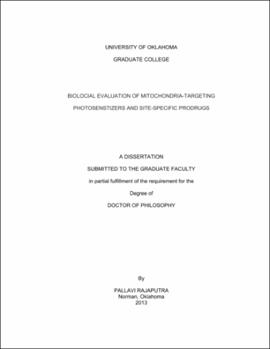| dc.contributor.advisor | West, Ann||You, Youngjae | |
| dc.creator | Rajaputra, Pallavi | |
| dc.date.accessioned | 2019-04-27T21:41:31Z | |
| dc.date.available | 2019-04-27T21:41:31Z | |
| dc.date.issued | 2013 | |
| dc.identifier | 9993047502042 | |
| dc.identifier.uri | https://hdl.handle.net/11244/319356 | |
| dc.description.abstract | This dissertation focuses on two different delivery mechanisms utilizing the principle of PDT with a goal to enhance the availability of the cytotoxic agent at the tumor site. | |
| dc.description.abstract | In one approach, which utilizes the higher mitochondrial membrane potential of cancerous cell mitochondria over the normal cell, compounds containing cations will be delivered to cancer cell mitochondria specifically. Delocalized lipophilic cationic dyes conjugated with porphyrin were used to improve the delivery of photosensitizer to mitochondria. Tetranitrogenic porphyrin, which absorbs around 650 nm, and either rhodamine B or acridine orange were used as porphyrin and cations. Due to their fluorescence properties, most of these dyes were visualized using fluorescence microscopy to confirm the mitochondrial localization. Uptake, photo and dark toxicity were then explored. | |
| dc.description.abstract | In a continuing project, core modified porphyrin photosensitizers with near IR absorption (690nm), high singlet oxygen quantum yield and known mitochondrial localizing cationic dyes like rhodamine B and triphenyl phosphene were explored. The photophysical properties of the conjugates like UV absorption, fluorescence, lipophilicity, singlet oxygen generation, and FRET efficiency were studied. Once it was confirmed that conjugation with cations did not alter the photophysical and singlet oxygen (SO) generation capacity of the dyes, biological evaluation was performed. All of these dyes, due to their fluorescence properties, were visualized using fluorescence microscopy to confirm mitochondrial localization. Uptake and photo and dark toxicity were explored. In vivo biodistribution studies show that the cation conjugated compound accumulated more in the tumor when compared to the photosensitizer itself. | |
| dc.description.abstract | In a different approach (of delivery), the site-specific delivery of porphyrin-anti-cancer prodrug conjugate to deliver and activate anti-cancer drug only at the tumor site was explored. Biological evaluation of these compounds was carried out to see that the concept works under in vitro conditions by exposing only a region of cells. Upon successful PDT the anti cancer drug was released to cause cell destruction. Once the concept was proved in vitro, in vivo studies were performed to see the anti tumor efficacy of the drugs. Additionally, the mechanism of cell death was also studied. | |
| dc.description.abstract | Overall, with this dissertation, the goal of delivering the cytotoxic agent to the tumor site and limiting its non-specific effect was achieved. | |
| dc.format.extent | 152 pages | |
| dc.format.medium | application.pdf | |
| dc.language | en_US | |
| dc.relation.requires | Adobe Acrobat Reader | |
| dc.subject | Photosensitizing compounds | |
| dc.subject | Cancer--Photochemistry | |
| dc.subject | Prodrugs | |
| dc.title | BIOLOCIAL EVALUATION OF MITOCHONDRIA-TARGETING PHOTOSENSTIZERS AND SITE-SPECIFIC PRODRUGS | |
| dc.type | text | |
| dc.type | document | |
| dc.thesis.degree | Ph.D. | |
| ou.group | College of Arts and Sciences::Department of Chemistry and Biochemistry | |
